Inbox and Environment News: Issue 443
March 22 - 28, 2020: Issue 443
Council: Temporary Suspension Of Bushcare Activities
Dear Bushcare Volunteers,
Due to the risk of Coronavirus (COVID-19) and acting on the advice and lead of NSW and Federal health authorities, Council has taken the precautionary decision to suspend all Bushcare volunteer programs effective immediately for a period of 4 weeks. This decision will be reviewed in two weeks’ time.
This means there will unfortunately be no Bushcare Volunteer sessions until further notice.
The primary factor in this decision is your health and welfare as a volunteer and that of your supervisors.
We will be updating all of you on an ongoing basis as more information becomes available.
We plan to maintain our Bushcare Update on a regular basis, so if you would like to subscribe to the Bushcare Update, please let me know and I will add you to our database.
Thank you in advance for your understanding - we really appreciate how passionate you all are about our natural environment and valuable bushland.
We look forward to having the Bushcare program up and running again as soon as is safe and practical.
Michael Kneipp
Environmental Volunteers Coordinator
Northern Beaches Council
Weed Cassia Now Flowering: Please Pull Out And Save Our Bush
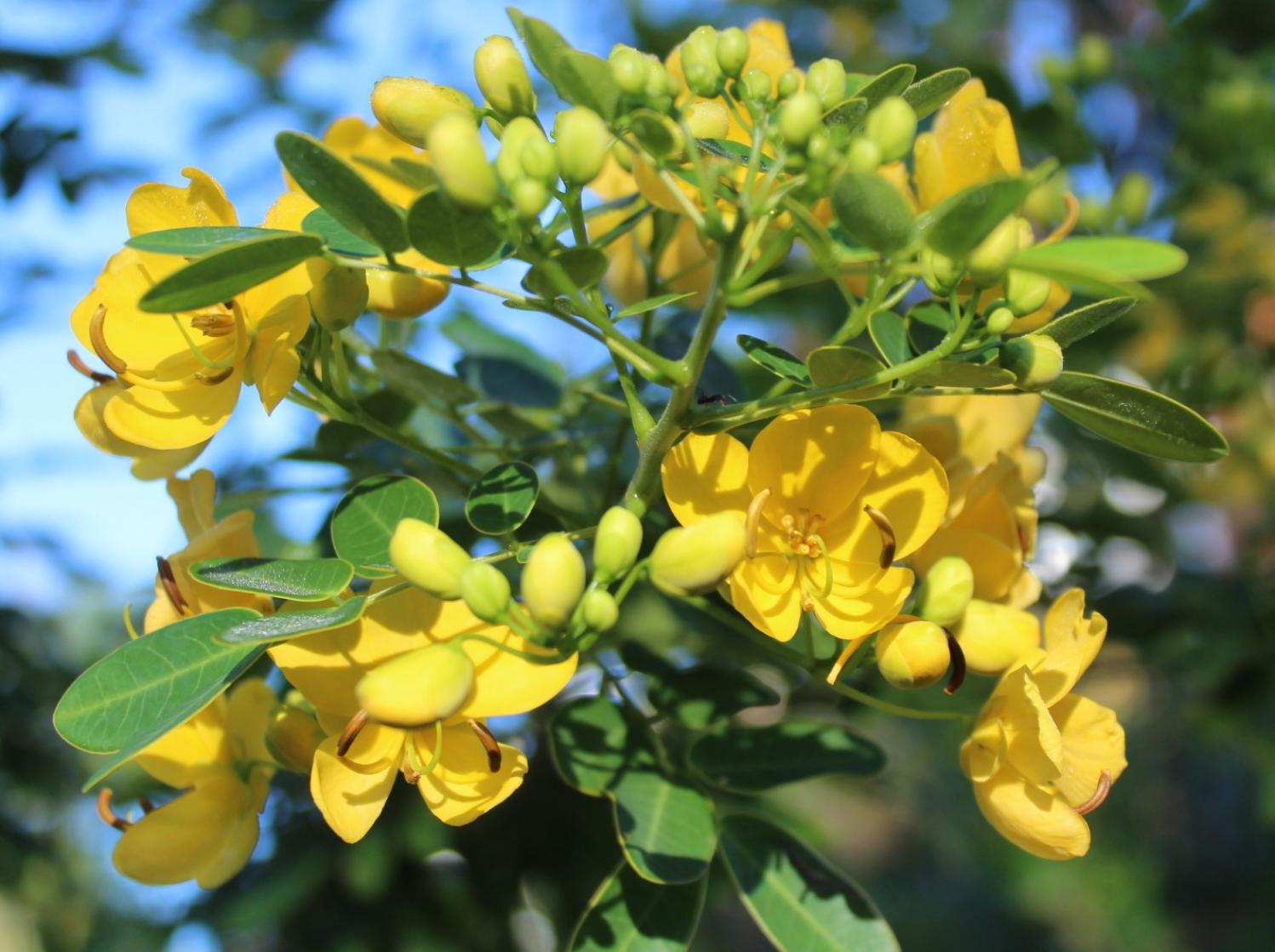
Currently Bearing Fruit - Lillipillis
Funghi Spotted This Week
FoNLC - May 25 Forum Cancelled Due To Covid-19
Greetings to all our members and supporters,
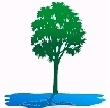 Northern Beaches Council have closed all their meeting venues including the Coastal Environment Centre due to the risk of spreading Covid-19 at public gatherings.
Northern Beaches Council have closed all their meeting venues including the Coastal Environment Centre due to the risk of spreading Covid-19 at public gatherings.
Accordingly, we have decided to cancel our May 25 forum which was to have been on the Aboriginal Significance of Wheeler Creek Valley.
I will keep a record of those of you who already have tickets to this event, and will make sure you are in your current booking position when we reschedule this forum. I will email all ticket holders presently in case some are not on this list.
You will be pleased to know that Dennis Foley, who was planning to drive up from Canberra to speak at this forum, is graciously willing to re-schedule another forum with us to focus on Wheeler Creek Valley heritage when the situation regarding Covid-19 has stabilised.
We will let you know what is happening as soon as we are able to plan future events.
For the moment our bookings for forums on the last Mondays of August and November still stand and we will keep monitoring the situation to see what is possible to be organised closer to those dates.
Meanwhile, stay safe and take good care of your own health and that of your family, your friends and your neighbours.
Judith Bennett
Secretary, Friends of Narrabeen Lagoon Catchment
Website: www.narrabeenlagoon.org.au
Kookaburra Fledglings This Week: Bigger - Ready To Flap And Feed On Their Own Two Wings!
Sunday March 15 And Monday March 16, 2020
Morning Of March 20th, 2020 - Fledglings And Parents
Late Afternoon - Friday March 20th, 2020
Saturday Afternoon, March 21, 2020
The Magpie Fledgling This Week
The Rainbow Lorikeets This Week
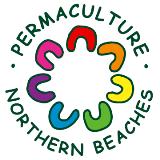 NB: Northern Beaches Council have closed all their meeting venues due to the risk of spreading Covid-19 at public gatherings.
NB: Northern Beaches Council have closed all their meeting venues due to the risk of spreading Covid-19 at public gatherings.Please Help Sydney Wildlife Rescue: Donate Your Cans And Bottles And Nominate SW As Recipient
You can Help Sydney Wildlife help Wildlife. Sydney Wildlife Rescue is now listed as a charity partner on the return and earn machines in these locations:
- Pittwater RSL Mona Vale
- Northern Beaches Indoor Sports Centre NBISC Warriewood
- Woolworths Balgowlah
- Belrose Super centre
- Coles Manly Vale
- Westfield Warringah Mall
- Strathfield Council Carpark
- Paddy's Markets Flemington Homebush West
- Woolworths Homebush West
- Caltex Concord road Concord West
- Bondi Campbell pde behind Beach Pavilion
- Westfield Bondi Junction car park level 2 eastern end Woolworths side under ramp
- UNSW Kensington
- Enviro Pak McEvoy street Alexandria.
Every bottle, can, or eligible container that is returned could be 10c donated to Sydney Wildlife.
Every item returned will make a difference by removing these items from landfill and raising funds for our 100% volunteer wildlife carers. All funds raised go to support wildlife.
It is easy to DONATE, just feed the items into the machine select DONATE and choose Sydney Wildlife Rescue.
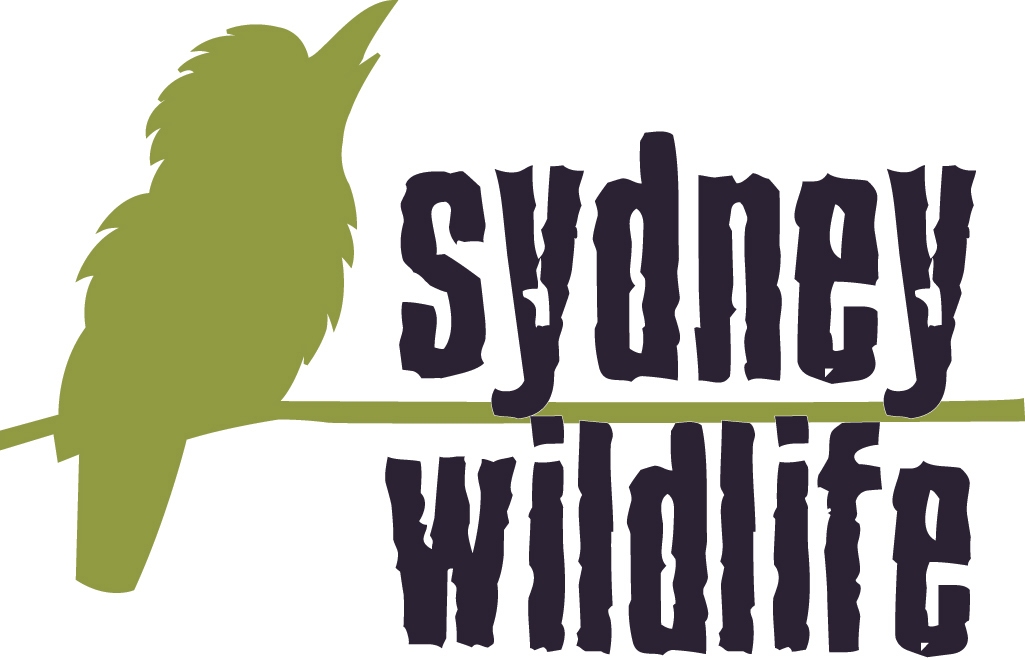
Friends Of Narrabeen Lagoon Catchment: Bushwalks 2020
 Sun 26/4/2020 Cromer Circle
Sun 26/4/2020 Cromer CircleBushcare In Pittwater
Where we work Which day What time
Avalon
Angophora Reserve 3rd Sunday 8:30 - 11:30am
Avalon Dunes 1st Sunday 8:30 - 11:30am
Avalon Golf Course 2nd Wednesday 3 - 5:30pm
Careel Creek 4th Saturday 8:30 - 11:30am
Toongari Reserve 3rd Saturday 9 - 12noon (8 - 11am in summer)
Bangalley Headland 2nd Sunday 9 to 12noon
Bayview
Winnererremy Bay 4th Sunday 9 to 12noon
Bilgola
North Bilgola Beach 3rd Monday 9 - 12noon
Algona Reserve 1st Saturday 9 - 12noon
Plateau Park 1st Friday 8:30 - 11:30am
Church Point
Browns Bay Reserve 1st Tuesday 9 - 12noon
McCarrs Creek Reserve Contact Bushcare Officer To be confirmed
Clareville
Old Wharf Reserve 3rd Saturday 8 - 11am
Elanora
Kundibah Reserve 4th Sunday 8:30 - 11:30am
 Mona Vale
Mona Vale Mona Vale Beach Basin 1st Saturday 8 - 11am
Mona Vale Dunes 2nd Saturday +3rd Thursday 8:30 - 11:30am
Newport
Bungan Beach 4th Sunday 9 - 12noon
Crescent Reserve 3rd Sunday 9 - 12noon
North Newport Beach 4th Saturday 8:30 - 11:30am
Porter Reserve 2nd Saturday 8 - 11am
North Narrabeen
Irrawong Reserve 2nd Saturday 2 - 5pm
Palm Beach
North Palm Beach Dunes 3rd Saturday 9 - 12noon
Scotland Island
Catherine Park 2nd Sunday 10 - 12:30pm
Elizabeth Park 1st Saturday 9 - 12noon
Pathilda Reserve 3rd Saturday 9 - 12noon
Warriewood
Warriewood Wetlands 1st Sunday 8:30 - 11:30am
Whale Beach
Norma Park 1st Friday 9 - 12noon
Western Foreshores
Coopers Point, Elvina Bay 2nd Sunday 10 - 1pm
Rocky Point, Elvina Bay 1st Monday 9 - 12noon
Gardens And Environment Groups And Organisations In Pittwater
Pittwater Reserves
Victoria quietly lifted its gas exploration pause but banned fracking for good. It’s bad news for the climate
Samantha Hepburn, Deakin UniversityAmid coronavirus chaos, the Victorian government announced its decision earlier this week to lift the ban on onshore gas exploration, but also to make the temporary state-wide ban on fracking permanent.
This decision was made three years after an investigation found gas reserves in the state could be extracted without any environmental impacts, and new laws will be introduced to parliament for drilling to start in July next year.
Read more: Fracking policies are wildly inconsistent across Australia, from gung-ho development to total bans
The state government first introduced the moratorium (temporary ban) on onshore conventional and unconventional gas production in 2017, enshrined in the Mineral Resources (Sustainable Development) Act 1990. It effectively made it an offence to either conduct coal seam gas exploration or hydraulic fracturing (fracking) until June 2020.
The ban was originally imposed amid strong concerns about the environmental, climate and social impacts of onshore gas expansion. But lifting the ban to allow conventional gas exploration while banning fracking and unconventional gas (coal seam gas), doesn’t remove these concerns.
The Fracking Ban Isn’t So Permanent
The new laws seek to do two things: lift the ban on conventional onshore gas production, and to entrench a ban on fracking and coal seam gas exploration into the state constitution.
The government has stated it wants to make it difficult for future governments to remove the fracking ban. But this is highly unlikely to be legally effective. Unlike the federal constitution, the Victorian constitution is an ordinary act, and so it can be amended by another legal act.
The only way entrenching an amendment in the state constitution so that it is permanent and unchangeable is if it relates to the operation and procedure of parliament. And fracking does not do this.
This raises the spectre of a future government removing the fracking ban in line with an accelerating onshore gas framework.
Conventional Vs Unconventional Gas
The main difference between conventional gas and unconventional gas (coal seam gas) lies in their geology.
Conventional gas can generally be extracted without the need to frack, as gas can move to the surface through gas wells. To release unconventional gas, particularly shale gas, fracking is always required.
Read more: Explainer: what is energy security, and how has it changed?
Fracking technologies risk water quality from ground disturbances, spills, the release of chemicals and other fluids, and the underground migration of gases and chemicals.
So lifting the conventional onshore gas ban while keeping the fracking ban will mean less risk to the environment. But extracting conventional gas is still risky.
Greenhouse Gas Leaks
Extracting conventional gas risks fugitive emissions. This refers to greenhouse gases, such as methane, that can escape into the atmosphere during mining fossil fuels, such as from equipment leaks, deliberate or accidental venting, or from gas flaring.
Precise measurements of the fugitive emissions from onshore conventional gas production are difficult to predict, but their effect on climate change is alarming.
The latest estimates indicate fugitive emissions account for approximately 6% of Australia’s national greenhouse gas emissions. Fugitive emissions also have about 27 times the greenhouse harming potential of carbon dioxide.
In 2017, the Australian Gas Industry argued well managed sites produce little fugitive emissions, and poorly managed sites were responsible for 75% of fugitive emissions.
This means any expansion of onshore conventional gas must be accompanied by strict management and regulation. But there’s no industry-wide code of practice in Victoria focused on reducing this emissions risk.
Increasing Annual Emissions
Even in the unlikely scenario of zero or limited fugitive emissions, expanding conventional gas exploration will still add to Victoria’s annual greenhouse gas emissions.
The proposed laws follow the conclusions of a three-year study that reviewed the climate, environmental, economic and social impacts of gas exploration in Victoria.
The report suggested a slight increase in absolute annualised greenhouse gas emissions. In other words, Victoria’s annual greenhouse gas emissions would be proportionately increased by lifting the ban.
It also suggested expanding gas development would contribute between only 0.1% and 0.2% of Victoria’s annual greenhouse gas emissions, and that this wouldn’t affect Victoria’s 2050 net-zero target.
But 0.1% to 0.2% still amounts to releasing an additional 122,000 to 329,000 tonnes of CO₂ equivalent into the atmosphere.
What’s more, this assessment completely ignores emissions released through increased gas usage within the community. Globally, CO₂ emissions from natural gas use rose almost 200 million metric tons in 2019 and were responsible for two-thirds of the global emissions increase.
What It Means For The Community
The report predicts 242 jobs, A$312 million in gross regional product and A$43 million in royalties for Victoria. But overall, gas prices in the east coast market won’t change.
Read more: Australia has plenty of gas, but our bills are ridiculous. The market is broken
The additional 128-830 petajoules (a joule is a measure of thermal energy and a petajoule is a million billion joules) that is potentially capable of being produced by lifting the moratorium will not be enough to address the forecast shortfall.
For the communities around the gas exploration sites, the report indicates the social impact of lifting the moratorium would be manageable.
The report indicates that 80% of the south-west and Gippsland communities – from more than 800 engagements with industry, farmers, local school students, and environmental community groups – either supported or tolerated onshore conventional gas development if noise or disturbances were appropriately addressed through regulation. But industry wide codes of behaviour are yet to be implemented.
Read more: When it comes to climate change, Australia's mining giants are an accessory to the crime
At What Cost?
Lifting the ban on onshore conventional gas in Victoria comes at a time when the need to reduce greenhouse gas emissions is profoundly important.
Climate change is accelerating. While gas may be an important resource as we transition to renewable energy, accelerating its production, particularly in the absence of stringent regulatory controls, comes at a very high price.![]()
Samantha Hepburn, Director of the Centre for Energy and Natural Resources Law, Deakin Law School, Deakin University
This article is republished from The Conversation under a Creative Commons license. Read the original article.
NSW To Lead The Nation On Emissions Reduction
March 15, 2020: NSW Government
The NSW economy will see over $11.6 billion of private investment and 2,400 new jobs under Stage 1 of the NSW Government’s plan to reach net zero emissions by 2050.
Energy and Environment Minister Matt Kean said the plan, the first of its kind in Australia, is all about reducing the State’s emissions in ways that grow the economy.
“Where there are technologies that can reduce both our emissions and costs for households and businesses, we want to roll them out across the State. Where these technologies are not yet commercial, we want to invest in their development so they will be available in the decades to come,” Mr Kean said.
“Almost two-thirds of the private investment under the plan will go to regional and rural NSW, creating job opportunities and diversifying local economies that are doing it tough after the drought and devastating bushfire season.
“Global markets are rapidly changing in response to climate change, with many of the world’s biggest economies and companies committed to reach net zero emissions by 2050. NSW already leads the nation with its economic and investment plans and from today, NSW will lead the nation with its Net Zero Plan.
“Our actions are firmly grounded in science and economics, not ideology, to give our workers and businesses the best opportunity to thrive in a low-carbon world.”
Under the plan, household electricity prices will fall, regional businesses will have access to new technologies and markets, industry will be supported to modernise their plant and increase productivity and consumers will have more information to help them make financially and environmentally sustainable choices.
The plan is financially supported by the landmark $2 billion bilateral agreement between the Commonwealth and NSW Government announced in January 2020.
Frabjous Days With Fuscous Honeyeaters – Capertee Valley
Published March 18, 2020 by BIBY TV
These Fuscous Honeyeaters (Ptilotula fusca) were filmed between early August and early October 2019 in the Capertee Valley (NSW). The precise location is a conservation property in the Glen Alice section of this geological wonder. Despite all the water scenes, 2019 was a drought year (like 2017 and 2018) with rainfall well under average. The year had a promising start however, with more than half the yearly total occurring in January. After an exceptionally low figure for February, March saw topped-up soil moisture and dams due to somewhat above average rain. But then the long dry period kicked in. Between early April and mid September it was alarmingly dry, with a likely total of less than 20mm across this time (based on own observations and nearby weather stations). If the birds of the valley had to rely on natural water sources, then options would have been limited as ephemeral creeks were largely dry and the Capertee River was a series of (shrinking) water holes. But at the filming site, the situation seemed more benign as all the usual storages (ex-farm dams and an old quarry) had some water. A bird bath and small pond evaporate quite quickly so we replenished them with tank water. Come mid September, there was cause for celebration, with hope-inducing around-average rainfall for this month. (The location photo was taken early October. In an average year the scene would be greener.) But our joy was short-lived. The October to December 2019 period was the driest on record for this time of year, with the hotter weather now evaporating exposed water more rapidly. Late October also brought the beginning of Australia’s largest forest fire on record (Gospers Mountain fire), which was ignited by lightning not far from this property.
Across the period related to this video though, we were buoyed by an abundance of birdlife visiting the various water sources. Honeyeaters in general were especially numerous and active, with all species foraging for variety of foods (e.g. insects, lerps and nectar). While Fuscous Honeyeaters are often described as plain or dowdy, we think their subtle colouring is stunning in sunshine (and we had plenty due to the drought). Moreover, their rollicking calls were a wonderful soundtrack to our visits (particularly in August and July). We have included a continuous sound file across the three photos. (Other calls in that section are Little Corella, Australian Raven and Little Lorikeet). Just as our worry went up a notch over the lack of rain, mid September falls were a huge relief. In short, our Fuscous filming days could be described as rather frabjous! Now we are all facing another difficult challenge in the form of Covid-19. But the good news from the valley is that late summer 2020 rain has the river flowing, dams replenished and the greenest pasture we have ever seen. And thanks to the hardworking local brigades, supportive community, the NPWS and visiting fire-fighters, much of the valley was spared the ravages of fire, including this property.
You may notice slight differences between individual Fuscous Honeyeaters. Young Fuscous are usually duller or browner with less distinct plumes on their necks. Nonetheless, we have observed variations in colouring and plumes across adults too. Breeding adult birds have an entirely black bill, while juveniles and non-breeding adults have more yellow. (Juveniles also have a fleshy orange-yellow gape.) Eye colour also changes for breeding birds.
Baby Boom For The Bellinger River Snapping Turtle
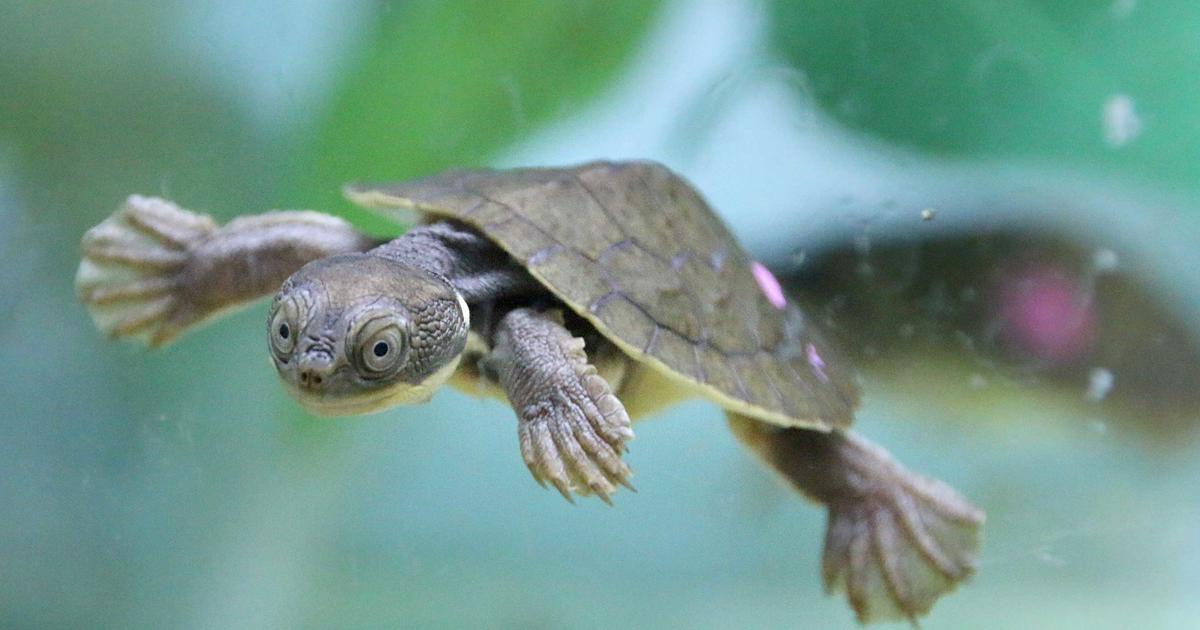
While On Turtles: Turtlely Cute Hatchlings Cause For Shellabration
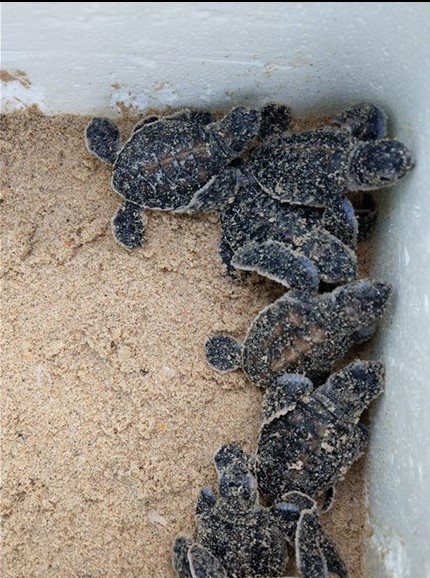
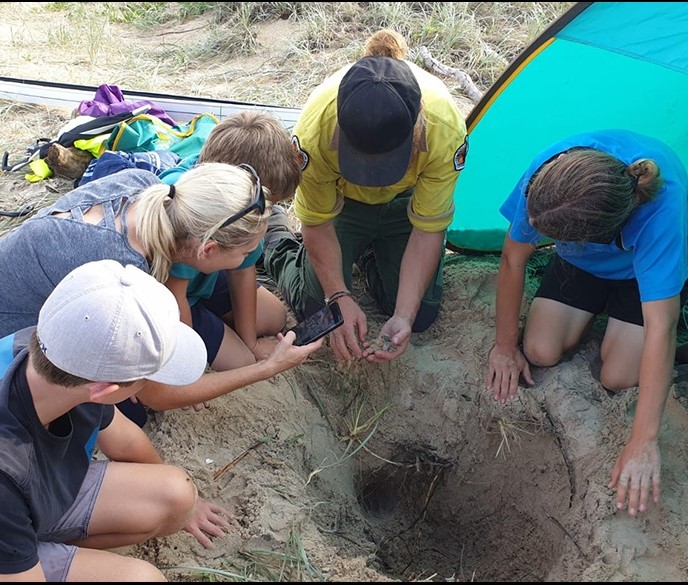
WaterNSW Welcomes Land And Environment Court Decision
Upgrade Works To Halt Water Releases From Toonumbar Dam
Keepit Dam To Deliver First Water In More Than A Year
Dubbo Area Water User Convicted And Fined $18,900
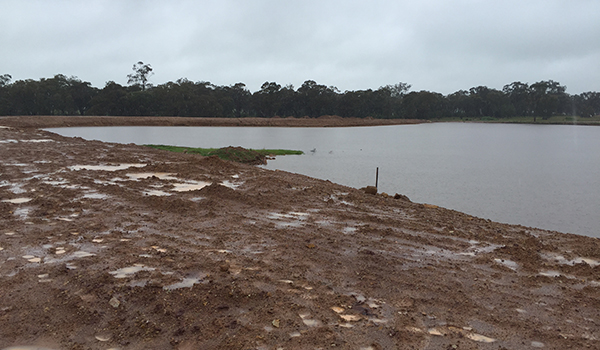 The landholder pleaded guilty to and was convicted of three charges brought by the Natural Resources Access Regulator (NRAR) relating to taking water without a licence, extending a dam without approval and failing to comply with directions, which included dewatering and removing the dam.
The landholder pleaded guilty to and was convicted of three charges brought by the Natural Resources Access Regulator (NRAR) relating to taking water without a licence, extending a dam without approval and failing to comply with directions, which included dewatering and removing the dam.Sydney Water Fined $30,000 For Inadequate Clean-Up Of Sewer Overflows
Quarry Solutions Fined For Operating Without Environment Protection Licence
New Research First To Relate Antarctic Sea Ice Melt To Weather Change In Tropics
March 16, 2020: University of California - San Diego
Arctic and Antarctic ice loss will account for about one-fifth of the warming that is projected to happen in the tropics, according to a new study led by Mark England, a polar climate scientist at Scripps Institution of Oceanography at the University of California San Diego, and Lorenzo Polvani, the Maurice Ewing and J. Lamar Worzel Professor of Geophysics at Columbia Engineering, England's doctoral supervisor.
While there is a growing body of research showing how the loss of Arctic sea ice affects other parts of the planet, this study is the first to also consider the long-range effect of Antarctic sea ice melt, the research team said.
"We think this is a game-changer as it shows that ice loss at both poles is crucial to understanding future tropical climate change," England said of the study funded by NASA and the National Science Foundation. "Our study will open a hitherto unexplored direction and motivate the science community to study the large effects that Antarctic sea ice loss will have on the climate system."
The years 2017 and 2018 set records for minimum sea ice extent in Antarctica. England and colleagues from Columbia University's School of Engineering, Colorado State University, and the National Center for Atmospheric Research in Colorado used computer simulations to see what scenarios play out near the equator if that decline continues through the end of the century. They found that Antarctic sea ice loss combines with Arctic sea ice loss to create unusual wind patterns in the Pacific Ocean that will suppress the upward movement of deep cold ocean water. This will trigger surface ocean warming, especially in the eastern equatorial Pacific Ocean. Warming there is a well-known hallmark of the El Niño climate pattern that often brings intense rains to North and South America and droughts to Australia and other western Pacific countries.
As that surface ocean water warms, it will also create more precipitation. Overall, the researchers believe the ice loss at both poles will translate to a warming of the surface ocean of 0.5℃ (0.9℉) at the equator and add more than 0.3 millimeters (0.01 inches) of rain per day in the same region.
This study joins several new analyses of the global impact of polar ice loss, including a January analysis by Scripps Oceanography physicist Charles Kennel suggesting that shrinking Arctic ice might change key characteristics of El Niño in the future.
Mark R. England, Lorenzo M. Polvani, Lantao Sun, Clara Deser. Tropical climate responses to projected Arctic and Antarctic sea-ice loss. Nature Geoscience, 2020; DOI: 10.1038/s41561-020-0546-9
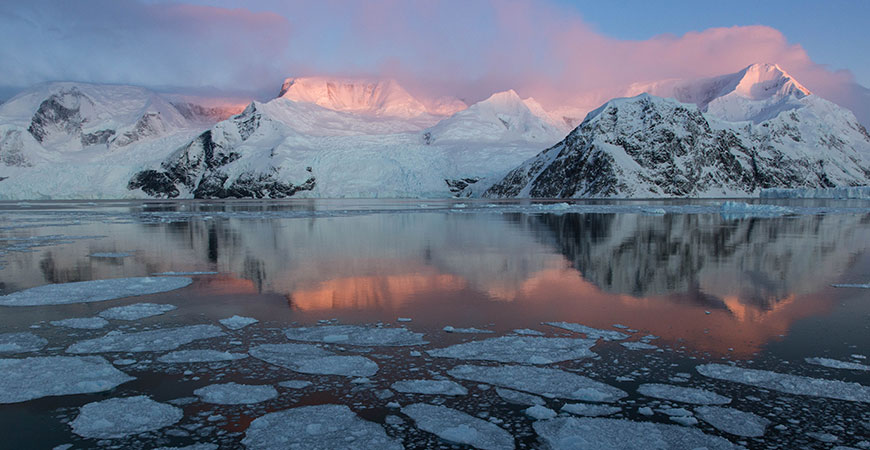
Pancake ice in Antarctica's Andvord Bay. Photo: Maria Stenzel
Aussie Bread Tags Collection Points

Zoos Victoria Now Live Streaming Animals: Bringing The Zoo To You
Dorothea Mackellar Poetry Awards 2020
It's been a few years since we reminded you of this one - but it's on again, entries close June 30th, and this may be the year you send yours in!
Named for a lady poet who had a lovely place at Lovett Bay and for whom our electorate is named - The Dorothea Mackellar Poetry Awards are back!
2020 OPTIONAL THEME: "WE USED TO LIVE THERE”
"Our poets are encouraged to take inspiration from wherever they may find it, however if they are looking for some direction, competition participants are invited to use this year's optional theme to inspire their entries."
In 2020, the Dorothea Mackellar Memorial Society has chosen the theme “We Used to Live There.” Instantly a nostalgic feeling of home and belonging washes over you, but we’re sure Australian students will surprise us with their interpretations. As always, it is an optional theme, so please write about whatever topic sparks your poetic genius.
For a copy of the wonderful theme poster, please click here.
About
In 1983, Mrs Maas (OAM PHF), with the support of volunteer judges Rosemary Dobson and Joan Phipson and local poet Anne Bell, orchestrated the foundation of the Dorothea Mackellar Memorial Society Inc. – the body that now hosts the Dorothea Mackellar Poetry Awards. It comprises a volunteer committee of community members from a wide range of backgrounds.
The poetry competition has grown from 300 entries in 1984 to tens of thousands of entries each year from school students across the nation. The competition also has a dedicated following from teachers whose support is integral to its continued success.
Jean Isherwood was also deeply touched by My Country and in 1983 set herself the task of painting a series of watercolours that she hoped would reflect the beauty described in the verses. This collection can be viewed at the Mackellar Centre.
THE DOROTHEA MACKELLAR SCULPTURE
The Dorothea Mackellar statue is now one of Gunnedah’s most visited landmarks.
For the historians, the bronze statue was constructed in 1983 by a well know sculptor Dennis Adams and faces towards Kurrumbede and The Rampadells, the Mackellar family holdings in the early 20th century.
The parkland around the memorial has been developed and dedicated to the founder of the Dorothea Mackellar Memorial Society, Mrs Maas.
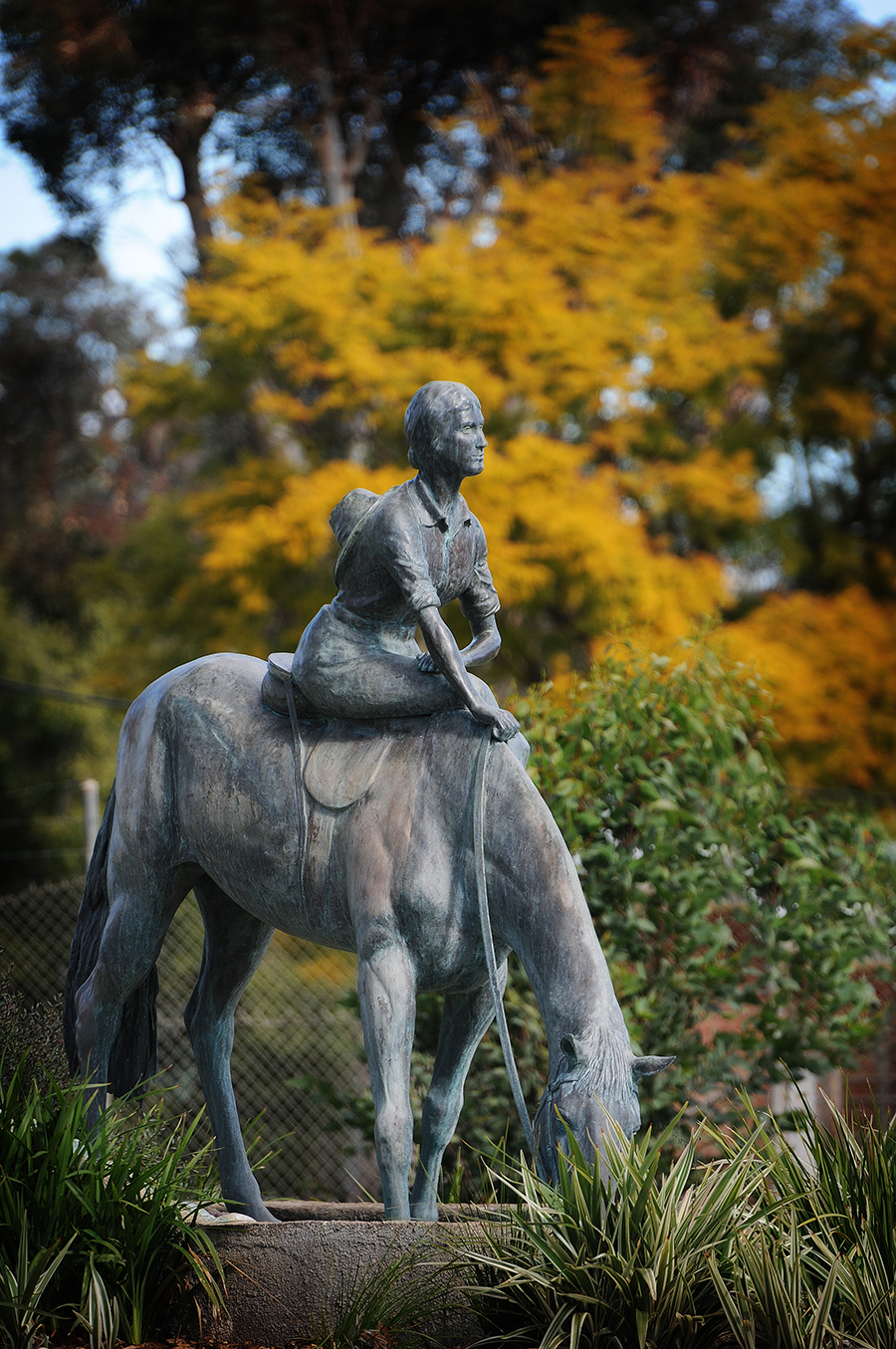
Dorothea Mackellar Statue
HOW TO ENTER
*PLEASE NOTE: If you're registering as an individual student, put your HOME address in your personal details and not your SCHOOL'S address! The address you list is where your participation certificate will be posted!*
ONLINE SUBMISSION
(primary school and secondary school, anytime during the competition period)
- Teacher/parent - registration completed online (invoice will be emailed within 2 weeks of registration)
- Log in to your page
- Enter student details and submit poem(s) (cut and paste or type in poem content direct to the webpage) PLEASE DO NOT UPLOAD POEMS AS ATTACHMENTS AS THAT FUNCTION IS FOR POSTAL ENTRIES ONLY.
- Repeat step 3 for every student/individual poem
SUBMISSION VIA MAIL (ADMINISTRATION FEE APPLIES- SEE CONDITIONS OF ENTRY FOR DETAILS)
(primary only)
PLEASE CONSIDER ONLINE ENTRY TO HELP US SAVE TIME AND REDUCE HUMANITY'S ENVIRONMENTAL FOOTPRINT.
- Teacher/parent - registration completed online (invoice will be emailed within 2 weeks of registration)
- Print out and complete entry form for/by each student. Entry form available here.
- Print out poems (text must be in a easily distinguishable font – Arial, Times New Roman, hand-written poems not accepted)
- Glue completed entry form to the back of each entry
- Teacher to collate all entries, enclose entry fee or a confirmation of payment and mail to the Dorothea Mackellar Poetry Awards, PO Box 113, Gunnedah, NSW, 2380
- Mailed entries are individually scanned and submitted online by the Awards’ organisers. Please consider online entry to help us save valuable time during this hectic period and reduce our environmental footprint. We can all make a difference.
USEFUL TIPS
- Have a read of the judges' reports from the previous year. They contain some very helpful advice for teachers and parents alike!
- It is recommended for schools to appoint a coordinator for the competition.
- Only a teacher/parent can complete the registration form on behalf of the student/child.
- Log-in details: username is the email address and a password of your choice.
- Log-in details can be given to other teachers/students for poem submission in class/at home.
- Log-in as many times as necessary during the competition period.
- Teachers can view progress by monitoring the number and content of entries.
- Individual entries are accepted if the school is not participating or a child is home schooled. Parent needs to complete the registration form with their contact details. Please indicate 'individual entry' under school name and home postal address under school address.
- Invoice for the entry fee will be sent to the registered email address within 2 weeks.
- ‘Participation certificate only’ option available for schools where pre-selection of entries has been carried out. Poems under this option will not be sent to judges, students will still receive participation certificate for their efforts.
Please read the Conditions of Entry before entering. Entries accepted: March 1 to June 30, results announced during early September.
NEED SOME INSPIRATION?
Check out our learning resources or browse the previous years’ themes and winning entries.
For more, please visit: https://www.dorothea.com.au/How-to-Enter-awards
AWARD CATEGORIES AND PRIZES
Lower Primary (Years K – 3)
Winner: $300, trophy and prize pack
Runner-up: $150 and prize pack
Upper Primary (Years 4 – 6, Inc. Year 7 in SA)
Winner: $400, trophy and prize pack
Runner-up: $200 and prize pack
Assisted Learning Primary
Winner: $400, trophy and prize pack
Runner-up: $200 and prize pack
Entries to be submitted by the teacher, eligibility criteria:
- students on assisted learning programs
- students with English as a second language.
Junior Secondary (Years 7 – 9)
Winner: $500, trophy and prize pack
Runner-up: $300 and prize pack
Senior Secondary (Years 10 – 12)
Winner: $500, trophy and prize pack
Runner-up: $300 and prize pack
Assisted Learning Secondary
Winner: $500, trophy and prize pack
Runner-up: $300 and prize pack
Entries to be submitted by the teacher, eligibility criteria:
- students on assisted learning programs
- students with English as a second language.
Schools’ Award
For schools that demonstrate effort, achievement and a high standard of entries, awarded at the judges’ discretion.
Winner Primary: $1000, trophy and prize pack
Winner Secondary: $1000, trophy and prize pack
Prize Packs
Prize packs include a unique trophy and a wonderful collection of books from a number of publishing houses and local businesses.
Find out more at: www.dorothea.com.au
.jpg?timestamp=1584475290791)
MSO Live Streaming Of Concerts: Rimsky-Korsakov's Scheherazade
NLA Ebooks - Free To Download
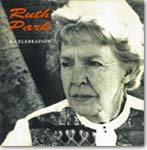 The National Library of Australia provides access to thousands of ebooks through its website, catalogue and eResources service. These include our own publications and digitised historical books from our collections as well as subscriptions to collections such as Chinese eResources, Early English Books Online and Ebsco ebooks.
The National Library of Australia provides access to thousands of ebooks through its website, catalogue and eResources service. These include our own publications and digitised historical books from our collections as well as subscriptions to collections such as Chinese eResources, Early English Books Online and Ebsco ebooks.Apply For The $200 Seniors Energy Rebate
- your valid CSHC from Centrelink or the DVA
- the most recent electricity bill for your current primary place of residence
- your contact details
- your bank or Credit Union account details
- Check you meet the eligibility requirements.
- Select the 'Apply online' button.
- Enter the required details.
- Submit the application.
Seniors' Stories Vol. 6 Writing Competition Now Open!
Rethinking Mortality And How We Plan For Old Age
Temporary Library Closures
Parkinson's Disease Linked To Gene Targeted By Blue-Green Algae Toxin
COVID-19: The Immune System Can Fight Back
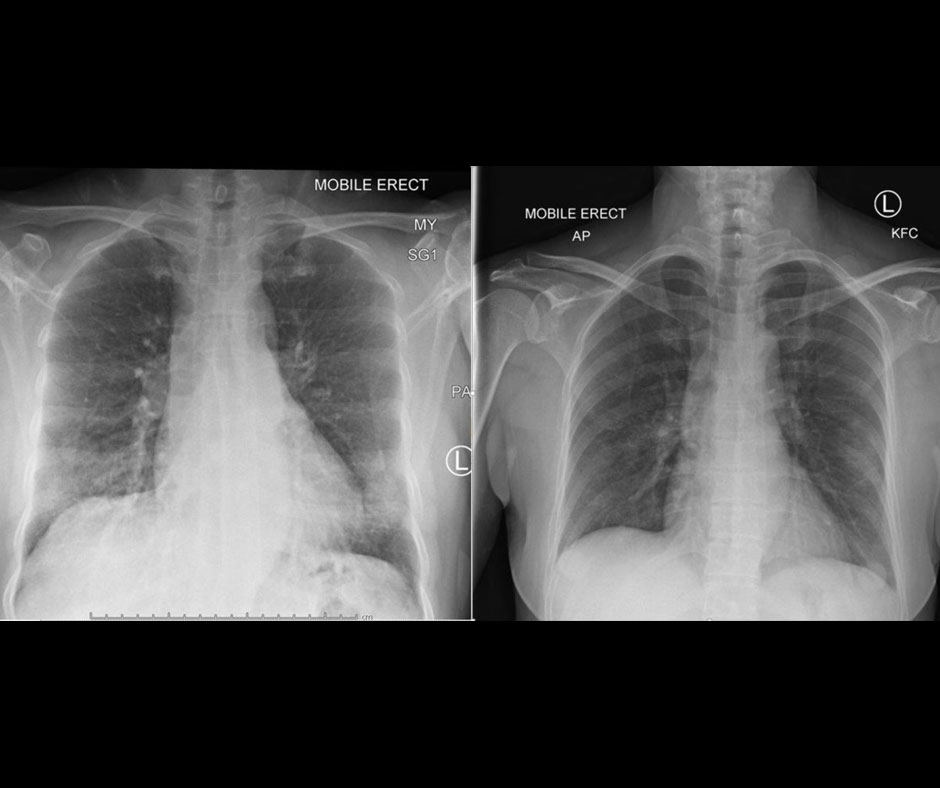
New Coronavirus Stable For Hours On Surfaces
- If the viability of the two coronaviruses is similar, why is SARS-CoV-2 resulting in more cases? Emerging evidence suggests that people infected with SARS-CoV-2 might be spreading virus without recognizing, or prior to recognizing, symptoms. This would make disease control measures that were effective against SARS-CoV-1 less effective against its successor.
- In contrast to SARS-CoV-1, most secondary cases of virus transmission of SARS-CoV-2 appear to be occurring in community settings rather than healthcare settings. However, healthcare settings are also vulnerable to the introduction and spread of SARS-CoV-2, and the stability of SARS-CoV-2 in aerosols and on surfaces likely contributes to transmission of the virus in healthcare settings.
- Avoid close contact with people who are sick.
- Avoid touching your eyes, nose, and mouth.
- Stay home when you are sick.
- Cover your cough or sneeze with a tissue, then throw the tissue in the trash.
- Clean and disinfect frequently touched objects and surfaces using a regular household cleaning spray or wipe.
COVID-19 Appears Less Severe In Children
Youth Law Australia: Providing Online Assistance To Children With Legal Problems
March 17, 2020: Kassi Klower, UNSW
Ensuring children have free access to legal assistance empowers and protects them.

Youth Law Australia Director Matthew Keeley (left) and Principal Solicitor Ahram Choi (middle). Photo: supplied.
When 16-year-old Sarah* was removed from Australia by her mother and left in another country with no passport and threatened to be married against her will, she reached out to Youth Law Australia, a not-for-profit organisation that provides free, comprehensive and confidential legal advice online to people under the age of 25.
“This matter really stuck with me because of the level of assistance we provided [Sarah]. Her advocate in Australia was able to connect her to us and we were able to give her legal advice, practical guidance on how to stay safe, and engage a lawyer to provide her with representation and bring her back safely,” says Ahram Choi, the Principal Solicitor for YLA.
Ms Choi says a high percentage of children and young people face legal issues. “The literature around legal need has identified that more than 50 percent of young people between 18 and 24 experience a legal problem every year, and we estimate about a quarter of young people under 18 experience a legal problem every year,” she says.
“Not all community legal aid will be able to advise young people on things like their civil issues. It's definitely an underserviced area.”
Previously called the National Children’s and Youth Law Centre, YLA was established in 1993. In the last financial year, they provided advice on more than 1500 legal matters from children all over Australia submitted through their online portal, from school uniform breaches and cyber-bullying matters through to issues of forced marriage and child abuse.
The online model works because it responds to how young people reach out for help, says YLA Director Matthew Keeley. “If we truly believe in helping children, we have to be available to them through the channels they prefer. Currently that's 24/7, through web form, phone or email. With more resources we could introduce live chat, text and other modes, ensuring every child’s communication needs or preferences are addressed,” he says.
“When young people reach out for help and don't get it, they may [incorrectly] surmise there's no point, so engendering a culture of help-seeking and finding is at the core of what we do.”
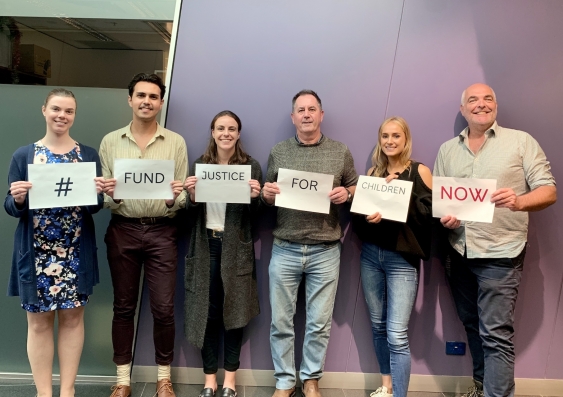
Youth Law Australia. Photo: supplied.
The law is often complicated, and children are particularly vulnerable in the legal system, so it is vital to explain the law in ways that make sense to them, says Mr Keeley. The centre educates and empowers them, putting them in a better position to protect themselves and increase their legal literacy.
If young people know “they can talk to a lawyer or counsellor, but also recognise that what has happened to them isn’t just morally wrong or unfair, but it is legally wrong” then the Centre has fulfilled its aim, says Maree Selvaraj, former project officer for YLA.
It’s important to ensure young people know they “have the right to seek a solution to that [legal] problem, regardless of age,” Ms Selvaraj says.
Ms Selvaraj worked with the YLA TeachLaw program that produces learning materials for teachers to educate young people in schools about their legal rights and responsibilities.
YLA relies on the generosity of organisations and volunteers who donate resources and time to the centre. UNSW provides the centre with facilities. Being based at UNSW means they are uniquely positioned to be research collaborators with both the Faculty of Law and the Social Policy Research Centre. There is a healthy stream of student volunteers and interns applying to work for YLA, and pro bono organisations, solicitors and law firms also donate time to draft legal advice through the online portal.
YLA also has a long history of leading children’s rights monitoring and reporting in Australia. They were integral in creating the National Children’s Commissioner role, and often make submissions to law reform inquiries or parliamentary inquiries, and report to the United Nations.
The centre liaises with other child rights-focused organisations to improve policy and legal practice.
“We were very influential in the framing of the Enhancing Online Safety for Children Act in 2014 and 2015, for example. The practice we created here of generating cease-and-desist notices to online bullies and other abusers formed the basis of similar notices within the legislation, and shows how our legal practice, research and advocacy can come together to affect positive change,” says Mr Keeley
For two decades, they have held leadership roles in the Child Rights Task Force, a delegation of NGOs that speak to the United Nations on Australia’s compliance with the Convention on the Rights of the Child. Due to inadequate government funding, they have been forced to resign from leading the taskforce.
“Not being able to participate in children’s rights implementation and advocacy to the level we should is a loss to the Australian community. Our unique insights and knowledge of the many legal problems confronting children all over Australia are now not able to be incorporated in those law reform and legal service planning contexts,” says Mr Keeley.
“The thing that is most profound about this organisation is that we aim to be there for any child in Australia, on any legal matter, at any time. We make no discrimination of any kind as to jurisdiction, legal matter or type of person we will assist. No other legal service in Australia can say this.”
*Name has been changed
To find out more about the services that Youth Law Australia provide, visit their website.
Thucydides and the plague of Athens - what it can teach us now

The coronavirus is concentrating our minds on the fragility of human existence in the face of a deadly disease. Words like “epidemic” and “pandemic” (and “panic”!) have become part of our daily discourse.
These words are Greek in origin, and they point to the fact that the Greeks of antiquity thought a lot about disease, both in its purely medical sense, and as a metaphor for the broader conduct of human affairs. What the Greeks called the “plague” (loimos) features in some memorable passages in Greek literature.
One such description sits at the very beginning of western literature. Homer’s Iliad, (around 700BC), commences with a description of a plague that strikes the Greek army at Troy. Agamemnon, the leading prince of the Greek army, insults a local priest of Apollo called Chryses.
Apollo is the plague god – a destroyer and healer – and he punishes all the Greeks by sending a pestilence among them. Apollo is also the archer god, and he is depicted firing arrows into the Greek army with a terrible effect:
Apollo strode down along the pinnacles of Olympus angered
in his heart, carrying on his shoulders the bow and the hooded
quiver; and the shafts clashed on the shoulders of the god walking angrily. …
Terrible was the clash that rose from the bow of silver.
First he went after the mules and the circling hounds, then let go
a tearing arrow against the men themselves and struck them.
The corpse fires burned everywhere and did not stop burning.
Plague Narratives
About 270 years after the Iliad, or thereabouts, plague is the centrepiece of two great classical Athenian works – Sophocles’ Oedipus the King, and Book 2 of Thucydides’ History of the Peloponnesian War.
Thucydides (c.460-400BC) and Sophocles (490-406BC) would have known one another in Athens, although it is hard to say much more than that for a lack of evidence. The two works mentioned above were produced at about the same time. The play Oedipus was probably produced about 429 BC, and the plague of Athens occurred in 430-426 BC.
Thucydides writes prose, not verse (as Homer and Sophocles do), and he worked in the comparatively new field of “history” (meaning “enquiry” or “research” in Greek). His focus was the Peloponnesian war fought between Athens and Sparta, and their respective allies, between 431 and 404 BC.
Thucydides’ description of the plague that struck Athens in 430 BC is one of the great passages of Greek literature. One of the remarkable things about it is how focused it is on the general social response to the pestilence, both those who died from it and those who survived.

A Health Crisis
The description of the plague immediately follows on from Thucydides’ renowned account of Pericles’ Funeral Oration (it is important that Pericles died of the plague in 429 BC, whereas Thucydides caught it but survived).
Thucydides gives a general account of the early stages of the plague – its likely origins in north Africa, its spread in the wider regions of Athens, the struggles of the doctors to deal with it, and the high mortality rate of the doctors themselves.
Nothing seemed to ameliorate the crisis – not medical knowledge or other forms of learning, nor prayers or oracles. Indeed “in the end people were so overcome by their sufferings that they paid no further attention to such things”.
He describes the symptoms in some detail – the burning feeling of sufferers, stomachaches and vomiting, the desire to be totally naked without any linen resting on the body itself, the insomnia and the restlessness.

The next stage, after seven or eight days if people survived that long, saw the pestilence descend to the bowels and other parts of the body – genitals, fingers and toes. Some people even went blind.
Words indeed fail one when one tries to give a general picture of this disease; and as for the sufferings of individuals, they seemed almost beyond the capacity of human nature to endure.
Those with strong constitutions survived no better than the weak.
The most terrible thing was the despair into which people fell when they realized that they had caught the plague; for they would immediately adopt an attitude of utter hopelessness, and by giving in in this way, would lose their powers of resistance.
Lastly, Thucydides focuses on the breakdown in traditional values where self-indulgence replaced honour, where there existed no fear of god or man.
As for offences against human law, no one expected to live long enough to be brought to trial and punished: instead everyone felt that a far heavier sentence had been passed on him.
The whole description of the plague in Book 2 lasts only for about five pages, although it seems longer.
The first outbreak of plague lasted two years, whereupon it struck a second time, although with less virulence. When Thucydides picks up very briefly the thread of the plague a little bit later (3.87) he provides numbers of the deceased: 4,400 hoplites (citizen-soldiers), 300 cavalrymen and an unknown number of ordinary people.
Nothing did the Athenians so much harm as this, or so reduced their strength for war.
A Modern Lens
Modern scholars argue over the science of it all, not the least because Thucydides offers a generous amount of detail of the symptoms.
Epidemic typhus and smallpox are most favoured, but about 30 different diseases have been posited.
Thucydides offers us a narrative of a pestilence that is different in all kinds of ways from what we face.
The lessons that we learn from the coronavirus crisis will come from our own experiences of it, not from reading Thucydides. But these are not mutually exclusive. Thucydides offers us a description of a city-state in crisis that is as poignant and powerful now, as it was in 430BC.![]()
Chris Mackie, Professor of Classics, La Trobe University
This article is republished from The Conversation under a Creative Commons license. Read the original article.
Australian Tiny Homes: Free Webinar
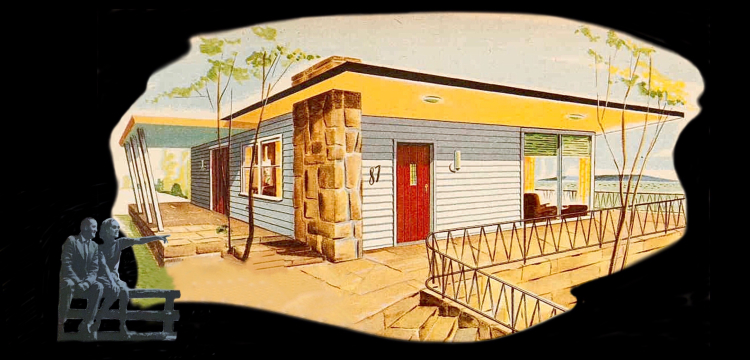
Plastic Building Bricks Could Survive In Ocean For Up To 1,300 Years
How Plants Sound The Alarm About Danger
Children’s Racial Discrimination Linked To Health Risks
Disclaimer: These articles are not intended to provide medical advice, diagnosis or treatment. Views expressed here do not necessarily reflect those of Pittwater Online News or its staff.